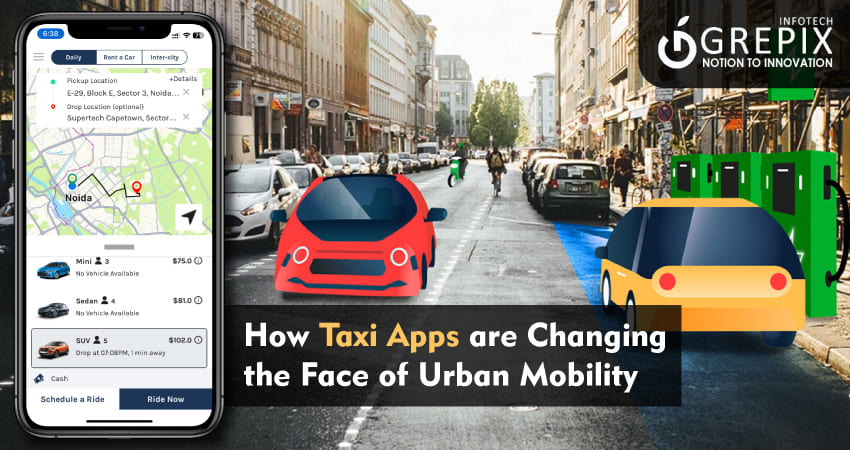How Taxi Apps are Changing the Face of Urban Mobility
Taxi apps, such as Uber, Lyft, and Didi, have dramatically changed how people move around cities, shaping the urban landscape and influencing public and private transportation. Here’s a comprehensive look at how these apps are altering urban mobility, affecting transportation patterns, influencing city planning, and driving socioeconomic and environmental shifts.
Taxi apps like Uber, Lyft, and Didi have transformed urban transportation, offering unprecedented convenience, flexibility, and safety. These platforms streamline the user experience, reduce wait times, and contribute to a more dynamic and data-driven approach to city planning, influencing everything from public transit integration to car ownership trends. With their ability to gather valuable data and offer eco-friendly solutions like carpooling, taxi apps are key to modern urban mobility. Companies like Grepix Infotech play a pivotal role by developing scalable, user-friendly taxi app solutions that support cities' multi-modal transportation systems, ensuring sustainability, efficiency, and accessibility in urban mobility.
Introduction to Taxi Apps in Urban Mobility
The rise of taxi apps has marked a shift from traditional taxi services to app-based, on-demand ride-hailing services. Before these apps, people relied on public transportation, private vehicles, or street-hailing taxis. However, taxi apps have made it easy to book a ride, pay digitally, and reach destinations more conveniently, impacting how urban dwellers navigate cities.
Initially introduced to optimize existing taxi services, taxi apps rapidly evolved into a global phenomenon, reshaping urban mobility and challenging public transport systems. These services appeal to the convenience-driven lifestyle of today’s urban populations, with their promises of quick response times, cashless transactions, and flexible options, including carpooling.
1 Convenience and Accessibility
Taxi apps have introduced unparalleled convenience to city transportation. Previously, hailing a taxi meant standing on the street, often waiting a long time, or dealing with unavailability during peak hours. Today, users can access rides at the click of a button, knowing the estimated fare and time of arrival upfront. This accessibility has made transportation easier and faster, especially in cities where public transportation might be unreliable or limited in coverage. For people with mobility issues, elderly individuals, or those living in underserved neighborhoods, taxi apps offer a more flexible alternative to traditional options, increasing their independence and mobility.
2 Enhanced Efficiency and Reduced Wait Times
With integrated GPS systems and intelligent algorithms, taxi apps have optimized efficiency for both drivers and riders. By matching drivers to the nearest passenger, these apps reduce waiting time and fuel consumption, as drivers spend less time searching for fares. This matching efficiency is beneficial in dense urban areas where demand can be high.
Moreover, surge pricing charging higher rates during peak hours helps balance demand and supply, encouraging more drivers to operate during busy periods and ensuring that passengers willing to pay the premium can get rides more quickly. While surge pricing is sometimes controversial, it can incentivize drivers and optimize service availability when demand is highest.
3 Improved Safety Standards
Taxi apps have introduced enhanced safety protocols for both passengers and drivers. Features such as GPS tracking, driver ratings, and identity verification provide layers of security previously lacking in traditional taxi app development services. In-app emergency buttons and tracking capabilities ensure that friends or family can monitor trips, offering peace of mind for both riders and their loved ones.
Background checks and rigorous screening processes for drivers have also contributed to a safer environment. Unlike traditional taxi drivers, who may have varied levels of oversight, drivers in these networks are often subject to strict safety and behavior standards.
4 Economic Impact: Job Creation and the Gig Economy
Taxi apps have contributed significantly to the gig economy, providing income opportunities for millions of people around the world. For individuals who might not want or are unable to commit to traditional full-time employment, driving for a ride-hailing service offers flexibility and control over their working hours.
Significant effect is also had on local economies. Beyond direct employment, these platforms stimulate businesses in adjacent industries, including vehicle maintenance, insurance, and smartphone sales. However, the shift to gig work raises concerns about workers’ rights, with many drivers arguing for better benefits, job security, and wage protection. The classification of drivers as independent contractors rather than employees has led to legal battles in several countries, spotlighting a need for updated labor laws.
Also Read: "Top Challenges in Taxi App Development and How to Overcome Them"
5 Changing the Dynamics of Car Ownership
Taxi apps have influenced perceptions of car ownership, especially among younger generations in urban areas. Car ownership, once seen as a status symbol and necessity, has diminished in importance with the rise of on-demand transportation. For many urban residents, owning a car has become unnecessary, given the availability of reliable, quick, and often affordable ride-hailing services.
As fewer people own cars, cities experience reduced demand for parking spaces, potentially freeing up land for other uses, such as green spaces, bike lanes, and pedestrian areas. Urban planners are giving more thought to how this trend might alter the physical layout of cities, giving multimodal transportation choices precedence over streets dominated by cars.
6 Environmental Implications
The environmental impact of taxi apps is complex. On the one hand, these apps encourage shared mobility, with options such as carpooling services like UberPOOL or Lyft Line, potentially reducing the number of vehicles on the road and, by extension, emissions. The shift toward electric vehicles (EVs) within these networks further underscores a commitment to reducing environmental impact.
Studies, however, indicate that the ease of use of ride-hailing services might discourage using public transit and increase the number of "dead miles," or the distance drivers drive between passengers. In cities with already congested roads, ride-hailing services can exacerbate traffic and pollution. Thus, while these platforms have environmental benefits when used efficiently, their overall impact depends on user behavior, local infrastructure, and alternative, greener transportation options.
7 Influence on Public Transportation
The availability of on-demand rides has had both positive and negative effects on public transportation. In areas where public transit options are limited or inefficient, ride-hailing apps provide a valuable alternative, filling in “first mile, last mile” gaps and increasing accessibility to transit hubs.On the other hand, some studies indicate that the convenience and affordability of ride-hailing services can draw passengers away from public transportation, leading to decreased ridership and potentially impacting funding for these services. This trend has prompted cities to rethink how they can integrate taxi apps with public transit to create a cohesive, multi-modal urban mobility system.
In response, some cities have begun partnering with ride-hailing companies, subsidizing rides that complement public transit routes or serve low-density areas. This type of collaboration has the potential to enhance urban mobility, ensuring that both private and public transportation options are accessible, efficient, and sustainable.
8 Integration with Other Mobility Solutions
Taxi apps are increasingly part of a larger ecosystem of mobility solutions, including bike-sharing, car-sharing, and e-scooter rentals. As cities embrace a broader approach to urban mobility, ride-hailing services play a vital role in this landscape, offering flexible and immediate travel options that complement other modes of transport.
In the emerging “Mobility as a Service” (MaaS) model, users can access multiple transportation modes from a single app, facilitating seamless transitions from one mode to another. For example, a commuter might take an e-scooter to the train station, ride a train into the city, and then use a taxi app for the last mile. Integrating ride-hailing with other forms of transportation allows urban areas to optimize mobility options, creating a balanced and dynamic transport network.
9 Data-Driven Urban Planning
Taxi apps generate vast amounts of data that can be invaluable for urban planning. Data on trip origins, destinations, duration, and frequency provide insights into how people move across cities, helping planners identify underserved areas, high-demand corridors, and potential bottlenecks.
Some cities have partnered with ride-hailing companies to access anonymized data, which aids in making informed decisions about infrastructure investments, traffic management, and public transportation routes. This data-driven approach enables cities to respond proactively to residents' needs, enhancing urban mobility and accommodating future growth.
10 Social and Cultural Implications
Taxi apps have contributed to cultural shifts in how people interact with their cities. The rise of on-demand transportation has led to what some call a “mobility lifestyle,” where individuals are less tied to ownership and more accustomed to shared access. This change reflects a broader social trend toward shared economy services, emphasizing convenience, cost-efficiency, and flexibility over ownership and exclusivity.
Thanks to ride-hailing services, tourists can now explore foreign cities more conveniently and easily. The widespread use of these apps means that visitors can travel more easily to unfamiliar places without the need to learn local public transportation systems or navigate language barriers. This accessibility can enhance tourism and bring economic benefits to cities.
11 Challenges and Future Outlook
Despite their popularity and convenience, taxi apps face several challenges. Regulatory issues are prominent, as cities worldwide grapple with how to regulate these services in ways that balance innovation with fairness. Many cities impose licensing fees, caps on the number of drivers, and rules on fare structures to protect traditional taxi services and ensure fair competition.
There are also concerns over data privacy, as these apps collect substantial user data that could be susceptible to misuse or breaches. Balancing the need for data-driven insights with individuals' privacy rights is a delicate task, requiring clear policies and transparency from the companies involved.
As the industry matures, there is growing pressure on taxi apps to become more sustainable and socially responsible. With advancements in autonomous vehicles, taxi apps could eventually incorporate self-driving cars into their fleets, potentially lowering operational costs and changing how people perceive on-demand transportation. However, this shift will come with its own set of regulatory, ethical, and technological challenges.
Conclusion
In the rapidly evolving landscape of urban mobility, Grepix Infotech stands at the forefront, offering innovative, cutting-edge solutions for taxi apps that are helping to redefine urban transportation. Because ride-hailing apps such as Uber, Lyft, and Didi have made city life more convenient, accessible, and efficient, We have taken advantage of this trend and created customized software solutions that enable ride-hailing companies to prosper in this cutthroat market.
We have expertise in designing robust, scalable, and user-friendly taxi app solutions, businesses can harness the full potential of on-demand mobility, optimizing rider and driver experiences. Our solutions incorporate essential features like real-time tracking, GPS integration, and data analytics, which are crucial for aligning with today's data-driven urban planning needs and enhancing safety standards. Furthermore, Grepix recognizes the shift towards sustainable practices and works to integrate environmentally friendly options, including support for electric vehicles and carpooling.
As cities look to build multi-modal transportation systems that integrate seamlessly with public and private mobility options, Grepix Infotech’s solutions provide a strong technological backbone that enhances operational efficiency, user satisfaction, and regulatory compliance. By staying responsive to regulatory changes and privacy needs, We also ensure that our clients remain competitive and responsible in a dynamic market.
Looking out to start your own venture like Uber? Try out our HireMe Taxi Uber Clone, the easiest way to kick-start your taxi business.







